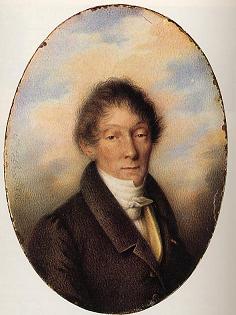
We mark the death, in Vienna, on March 2, 1830 – 190 years ago today – of the violinist and conductor Ignaz Schuppanzigh. Born in Vienna on November 20, 1776, he was 53 at the time of his death, reportedly of “paralysis”, whatever that’s supposed to mean.
Speaking generally but accurately, a measure of professional contentment can be hard to come by in the professional musical world. That’s because a professional career – for composers and performers alike – consists (particularly early in our careers when we are most vulnerable) of a seemingly endless sequence of (often failed) auditions; rejection; criticism (sometimes fair but more usually unfair); rejection; scratching out a living that is in no way commensurate with one’s talents and skills; and rejection. (Did I remember to mention “rejection”?)
Sure, what audiences see and hear during a concert performance are skilled musicians, playing their hearts out and receiving – in the end – applause for a job well done. But hang out afterward and scratch the scab that is any professional musician’s psyche, and the frustration will likely spurt forth like goobers from a lanced boil. One will rarely – if ever – meet a professional musician who, on being asked “how are you?” will respond “I can’t complain.” Because complain we must. Along with our opposable thumbs, the ability to complain elevates us from the beasts, and a career in the arts is perhaps the surest path to developing a virtuosity in the fine art of “the whine.”
It is my experience that composers are the most accomplished complainers of all. And why not? The sense of victimization that burns in the souls of so many musicians flares extra bright for composers. Hats in hands, we approach conductors with the same deference as Oliver Twist asking for more food, “a performance, please, Sir?”, only to be treated like a maggot discovered in oatmeal. Grantmaking organizations and competition juries dispense their largesse with a degree of arbitrariness that shames even those on the grant committees. Publishers and recording companies either reject our music outright or, having accepted it for publication, demand that the composer underwrite all or most of the costs involved. (When Beethoven accused his publishers of cheating him, he was not behaving well but he was probably correct.)
Having observed this often painful professional landscape let us celebrate the two things without which no composer could survive and for which every composer must be eternally grateful: our patrons and our performers.
Our patrons are those blessed, sainted individuals who out of love, artistic conviction, and the sheer goodness of their hearts finance the composition of works and/or the performance of those works.
Finally, in the end, it’s all about the performers. Without dedicated professional-level performers willing to take risks and spend their precious time learning new music that is not-infrequently unworthy of their time, the compositional community would wither and die. Which brings us, finally, to what was arguably the greatest one-two punch of patron and performer in the history of Western music: Count Andreas Kyrillovich Razumovsky and the violinist Ignaz Schuppanzigh.

Count (and later Prince) Andrey Razumovsky was a fabulously wealthy Russian diplomat posted to Vienna. With his own ducats he built a magnificent, neoclassic-styled palace just outside the old city walls in Vienna’s Landstrasse district (it can be visited today at Rasumofskygasse 24). Rasumovsky stocked his less-than-modest town house with the best ancient and modern art his great wealth could buy. But even more importantly, Razumovsky – himself a most competent violinist – stocked his casa with a professional string quartet.
Anton Schindler – Beethoven’s assistant and secretary on and off between 1822 and Beethoven’s death in 1827 – observed that:
“Count Razumovsky was a practicing musician. [He] would gather musicians in his palace to perform string quartet music, in which he himself played second violin. He placed a permanent quartet under a life-long contract. This was the first example of its kind in Austria. Other rich art lovers followed his example, establishing permanent quartets in their households. But none of them did what Razumovsky did, namely, to provide those artists with pensions for the rest of their lives.”
Schindler continues:
“This model quartet was composed of [Ignaz] Schuppanzigh, [Louis] Sina, [Franz] Weiss, and [Joseph] Linke. Under the name ‘Razumovsky Quartet’, they achieved not only a European fame but also a place in the history of music, for in fact, Razumovsky’s Quartet became equally ‘Beethoven’s Quartet’: it was as if this noble patron had engaged them exclusively for this purpose; they were placed at Beethoven’s complete disposal.”

At a time when string quartets were performed by amateurs or by professionals in informal, pickup groups, this Razumovsky String Quartet, ensconced in Count Razumovsky’s Palace (pictured above) and headed by its first violinist Ignaz Schuppanzigh, was the first full-time, fully professional string quartet. It became, as Schindler correctly points out, the model for every professional string quartet that followed.
Ignaz Schuppanzigh would have met the 22-year-old Beethoven soon after Beethoven arrived in Vienna from Bonn in late 1792, as he – Schuppanzigh – participated in informal string quartet readings at the home of Beethoven’s principal patron, Prince Karl Lichnowsky. Beethoven very likely studied violin with Schuppanzigh in 1793 and 1794, and they became great friends.
Schuppanzigh was reportedly a slim and handsome young man, though by the time he became important enough to have his portrait painted, he was anything but. By early middle age he became what today would be considered morbidly obese, and Beethoven – who, Don Rickles-like, teased his friends without mercy – never let him forget it. Beethoven called Schuppanzigh “M’lord Falstaff”, after Shakespeare’s fat, booze-swilling clown, a nickname equally inspired by Schuppanzigh’s rotundity and jollity. Beethoven even composed a couple of pieces in honor of Schuppanzigh’s girth, one of which is a short, comic choral work titled Lob auf den Dicken (which translates as “Praise to the Fat One”), WoO 100.

(Beethoven composed this little ditty in 1801, setting the following words of his own invention:
“Schuppanzigh ist ein Lump.
Wer kennt ihn nicht,
den dicken Sauermagen,
den aufgeblasnen Eselskopf?
O Lump Schuppanzigh,
o Esel Schuppanzigh,
wir stimmen alle ein,
du bist der größte Esel,
o Esel, hi hi ha.”
Schuppanzigh is a scoundrel
Who doesn’t know him,
the fat sour-belly,
the inflated ass’s head?
Oh scoundrel Schuppanzigh,
Oh donkey Schuppanzigh,
We all agree
that you are the biggest ass,
Oh ass, hahaha.
Nice. Hahaha. We can be sure that Schuppanzigh just loved that.)
When it was suggested to Beethoven that, perhaps he should lighten up on Schuppanzigh, he scoffed, telling Ferdinand Ries that Schuppanzigh:
“ought to be grateful if all my insults have caused him to lose a little weight!”
Beethoven’s student and friend Carl Czerny described Schuppanzigh as being:
“a short, fat, pleasure-seeking man . . . one of the best violin-players of the time, unrivaled in quartet playing, a very good concert artist and the best orchestral conductor of his day. No one knew how to enter into the spirit of the music better than he.”
The constant fat-shaming notwithstanding, Schuppanzigh’s loyalty to Beethoven never wavered, and he played a major role in Beethoven’s career in Vienna from the beginning to the end. He participated in more of Beethoven’s premieres than any other musician, from the Septet (in 1800) to the three opus 59 string quartets (composed in 1805 and 1806, and collectively known as the “Razumovsky Quartets”), to the String Quartet in F minor, Op. 95 (of 1810), and five of the six late string quartets: Opuses 127, 130, 132, 135 and the Grosse Fugue Op. 133. He performed as concertmaster for the premiere of Beethoven’s Ninth Symphony on May 7, 1824 and participated in tens – if not hundreds – of other performances of Beethoven’s chamber and orchestral music.
Schuppanzigh lived in St. Petersburg from 1816 to 1823, and it is likely that he was responsible for convincing the Russian aristocrat Prince Nikolai Borisovich Galitzine to commission Beethoven to compose the string quartets Opuses 127, 130, and 132! Like Razumovsky and Schuppanzigh, Galitzine and Schuppanzigh are a portrait of patron and performer in service of a composer!
Finally, it was “M’lord Falstaff” – Ignaz Schuppanzigh – who triggered one of Beethoven’s most famous outbursts.
As a reminder, the Russian ambassador to the Habsburg Court in Vienna was Count Andreas Razumovsky, who underwrote a performing quartet called – logically enough – the Razumovsky Quartet, a quartet that featured Ignaz Schuppanzigh as its first violinist.
The Count commissioned Beethoven to compose three string quartets for his house quartet. Composed on the heels of Beethoven’s revolutionary Symphony No. 3 (of 1804), these three “Razumovsky” string quartets of Op. 59 (of 1805-1806) were, at the time they were first performed, considered to be incomprehensible new music.
(I do not exaggerate. Beethoven biographer Alexander Thayer wrote that:
“Perhaps no works of Beethoven’s met a more discouraging reception from musicians and connoisseurs than the Op. 59 string quartets.”
One contemporary critic battered the Op. 59 quartets with a critical sap made from Beethoven’s own Op. 18 string quartets, which he had composed between 1798 and 1800. The critic wrote that Beethoven’s Opus 18 string quartets were distinguished by:
“Unity, utmost simplicity, and character, which raise them to the rank of masterworks and validate Beethoven’s place alongside the honored names of our Haydn and Mozart. [In contrast, these “new” quartets] indulge without consideration in the strangest and most singular whims of Beethoven’s bizarre imagination.”
Another, rather more sympathetic critic wrote that the Op. 59 quartets were:
“Deeply thought through and of excellent workmanship, but not comprehensible to the ‘public’”.
Taken all together then, we cannot fault the members of the Razumovsky Quartet or Ignaz Schuppanzigh entirely for what happened when they began reading through the first of Beethoven’s Op. 59 quartets, the F major. The members of the quartet began to giggle, thinking that Beethoven was just messin’ with their heads. Carl Czerny recalled:
“When Schuppanzigh and his quartet played the Quartet in F Major for the first time, they laughed and were convinced that Beethoven wanted to play a joke and that this was not the promised quartet at all!”
Beethoven – who was not known for having a sense of humor about his music – said nothing but rather, went into slow-burn-mode.
The explosion came soon enough. Schuppanzigh, perhaps beginning to realize that the quartet was not intended as a joke, stopped playing, turned to Beethoven, and complained that the music was hard to play. Beethoven’s furious response has become the stuff of legend:
“Do you think I worry about your [expletive deleted] fiddle when the MUSE SPEAKS TO ME?!?!???”
We can be assured that at that moment, the giggling – and the complaints about the difficulty of music – stopped.
For lots more on Beethoven’s string quartets, I would direct your attention to my Teaching Company/Great Courses survey Beethoven’s String Quartets, which can be examined and downloaded at here at RobertGreenbergMusic.com.
Listen on the Music History Monday Podcast
Podcast: Play in new window
Subscribe: Apple Podcasts | Spotify | Pandora | iHeartRadio | RSS | More
